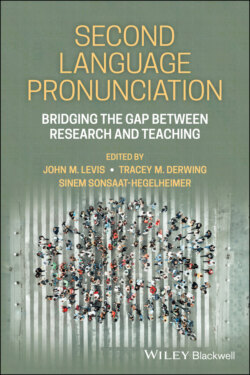Читать книгу Second Language Pronunciation - Группа авторов - Страница 37
Naturalistic L2 Pronunciation Development
ОглавлениеAs in L1 learning, L2 pronunciation naturalistically develops through experience with the ambient language. During the very earliest phases of adult L2 learning, aural and/or written input typically predominate as models for pronunciation. Unlike L1 learning, however, adult L2 learners are already effective communicators in one language and aspire to quickly experience similar success in their L2. This typically means that they will fail to develop accurate L2 perception before hastening to produce L2 speech. Their own productions then become the primary input to their new L2 system (Schmidt & Frota, 1986). Interestingly, younger L2 learners often go through a self-imposed silent period when first immersed in an L2 environment (Ervin-Tripp, 1974), lasting for up to six months (Winitz et al., 1995). This parallels the pattern observed in infant L1 phonological development, and at least in experimental conditions, appears to benefit learners’ pronunciation skills (Trofimovich et al., 2009). Trofimovich et al. argue that adult learners’ L2 pronunciation does not benefit from a similar silent period, but they provide no evidence to support this claim. Rather, it seems they view a silent period to be an impractical and unnecessary delay to adult learners’ ultimate social and employment goals.
Despite the fact that adult L2 learners attempt to speak before they have much experience with the perception of L2 sounds, there remains a short lag between improvement in perception and corresponding improvement in production. Summarizing the literature, Thomson (2022) reports that L2 perception scores are typically higher than L2 production scores for the same sound categories. Some counter-examples of L2 production accuracy surpassing perceptual accuracy do exist (Goto, 1971). However, most cases come from researchers whose explicit aim is to disprove the claim that perception precedes production (e.g., Borden et al., 1983; Bradlow et al., 1997; Sheldon & Strange, 1982). As Thomson (2022) notes, the reading task used to elicit speech in these studies allows learners to apply explicit knowledge of how to produce words based on spelling. Consequently, it is a strategy for bypassing natural progression, rather than proof that production can otherwise precede perception. There is also no evidence that such a strategy would extend to spontaneous communicative contexts.
In naturalistic contexts, when L2 pronunciation reaches a point where it is adequate for a learner’s communicative purposes, the motivation necessary to continue improving is likely to diminish. This may account for what Derwing and Munro (2015) have called the “Window of Maximal Opportunity” (WMO). While insufficient longitudinal data exists from which to accurately identify a precise point after which improvement in L2 pronunciation plateaus, evidence suggests that the WMO for obvious improvement in adult L2 learners’ pronunciation closes between six months and two years after their arrival in the L2 environment. The speed with which the WMO closes depends on individual learner characteristics (Piske et al., 2001). For example, not all learners struggle with the same L2 segments or suprasegmentals, even if they speak the same L1 (Derwing et al., 2012; Munro et al., 2015). Further, differences in phonetic aptitude predict ultimate attainment (Derwing & Munro, 2015; O’Brien et al., 2007). Some learners may be more fortunate than others in their access to input from the target speech community (Derwing et al., 2008), or they may have a stronger motivation to succeed (Baker Smemoe & Haslam, 2013; Moyer, 2014). Despite these limitations, there can be measurable improvement in individual sound categories beyond the WMO (Derwing & Munro, 2015). The effect of such incremental changes on L2 learners’ global foreign accent is limited, however. Derwing and Munro (2013) found no further improvement in English accent ratings for Slavic and Mandarin immigrants between two and seven years after their arrival in Canada. The Slavic group did evidence improvement in comprehensibility, however, which could be related to changes in pronunciation of individual sounds or suprasegmentals.
